The tour has always been at the heart of Universal Studios Hollywood. From 1915 when visitors sat on bleachers for 25 cents, via the 1964 introduction of pink and white GlamorTrams, to the current technological sophistication, the behind-the-scenes view of a working movie studio has been a key attraction. During the early years of the tram tour (1964 – 1977) all of the attractions at Universal were reached via the tram. With the introduction of the Screen Test Comedy Theater and the Animal Actors stage in 1977, the Upper Lot became an attraction in itself.
The tour originally departed from the Upper Lot. In 1991, it was moved to the Lower Lot following the construction of the Starway escalator system (see photo below)
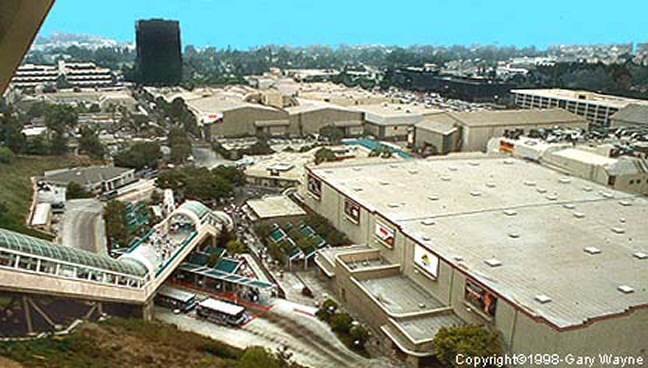
Trams Loading at the Lower Lot under the Starway, before Jurassic Park (c) Gary Wayne, Seeing Stars
On June 21 1994 the tour celebrated its’ 30th Anniversary. (Variety Article)
In 1996 it moved back to the Upper Lot to make room for Jurassic Park River Adventure on the Lower Lot.
As the movie studio continues to evolve, the tour evolves alongside it. In late 1989, CD players finally gave the tour guides a chance to rest their voices. In 2000, the CD players were replaced by DVD players and LCD screens, allowing the tour guides to show clips from the movies as the tram passes the locations.
In April 2014, Nighttime Studio Tours were announced – this extended the hours of the Studio Tour, and brought the backlot to life after dark, and paving the way for extended opening hours for the rest of the park following the opening of the Wizarding World of Harry Potter.
The World Famous Universal Studios Tour
(c) John Murdy, Universal Studios Hollywood
NB: This article was written in 2002.
The photographs have been added for interest, and were not published with the original article.
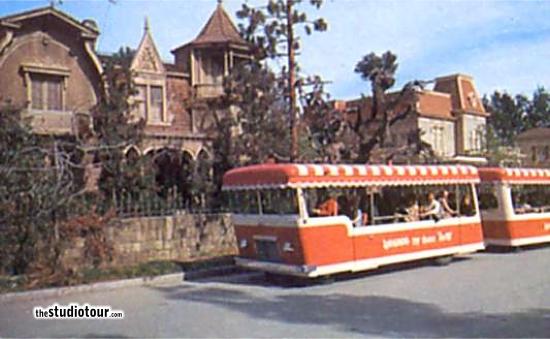
1964 GlamorTram outside the Munster House
THE UNIVERSAL STUDIO TOUR: INTRODUCTION
From its humble beginnings in the silent film era to its present position as the premiere behind-the-scenes Hollywood experience, the World Famous Universal Studio Tour has given over 100 million guests from around the world the rare opportunity to take a sneak peak into the inner workings of a Hollywood movie studio. In just under an hour, guests travel through a 415-acre movie lot that encompasses virtually every location and time period in the world (Ancient Rome, The Wild West, modern day New York). The one-of-a-kind guided tour includes face-to-face encounters with Hollywood icons (Jaws, King Kong), exclusive behind-the-scenes commentary from Hollywood’s greatest filmmakers (Ron Howard, Steven Spielberg, Stephen Sommers) and visits to some of the most famous sets in movie history (Psycho House, Whoville). Over 8,000 films and countless television shows have been shot on the Universal lot, making Universal Studios the most filmed location in the world and the Universal Studios Tour one of the most unique entertainment offerings in the world!
The Tour was officially founded in 1964, but it’s roots go all the way back to earliest days of film.
THE TOUR IN THE SILENT FILM ERA
In 1914 Universal Studios founder Carl Laemmle laid down a whopping $3,500 to purchase the Taylor Estate in Lankershim Township (the present site of Universal Studios Hollywood) and moved his burgeoning film studio from New York City to Southern California. Uncle Carl (a nickname he received because he had so many relatives on the pay roll) was the consummate showman and wanted to find a unique way to generate publicity about the move so in 1915 he held a grand opening ceremony where he invited the public to visit, “The World’s Only Movie City!” Thousands of people attended the gala opening including such luminaries as Thomas Edison, Buffalo Bill Cody and Valentino. In a bizarre foreshadowing of things to come, the entertainment for Uncle Carl’s grand opening included a western stunt show, the demolition of a bridge and a simulated flash flood; three attractions that would later become fixtures of the early Universal Studio Tour.
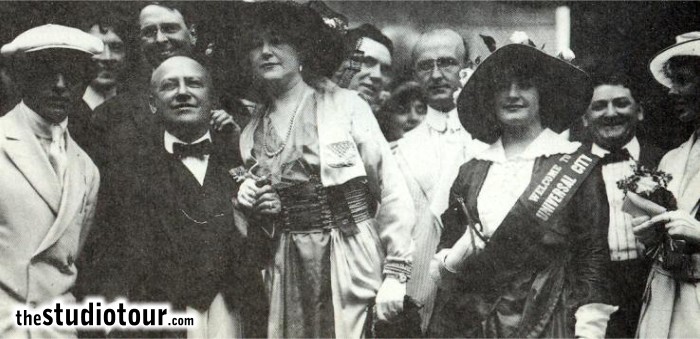
Gala Opening, 1915
After the gala opening, Mr. Laemmle continued to let the general public visit his “Movie City.” For an admission price of 25 cents (which also included a boxed lunch) guests sat in outdoor bleachers and were encouraged to cheer for the heroes and boo the villains! The advent of sound meant the end of the early Universal Studio tour (as the noise the visitors made now disrupted filming) and Universal closed its gates to the general public. Three decades would pass before the studio gates would open again.
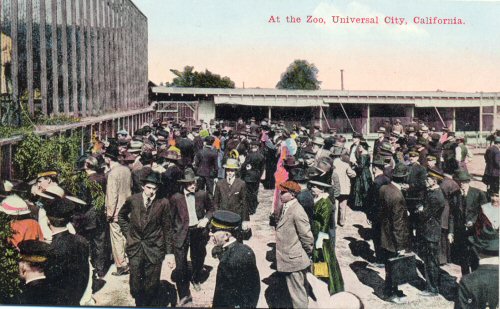
The Zoo at Universal City
THE MODERN UNIVERSAL STUDIOS TOUR
Ironically, the modern Universal Studio Tour was initially reborn as a way to sell more lunches in the Studio Commissary. The late 50’s and early 60’s were a difficult time for Hollywood studios. The arrival of television had weakened movie attendance and more and more productions were going on location to save costs. The grand old movie back lots were quickly becoming a thing of the past. In the mid 1950’s, Universal began letting bus companies drive on to the property (the same bus companies that offered guided tours of the homes of Hollywood stars) as a way to increase revenues. The studio charged the bus companies a small fee and also benefited from the extra lunches they could sell to the tourists in the Studio Commissary. The bus drivers were given a hand-typed script to read that highlighted the studio facilities as well as hyped upcoming Universal releases like Bonzo Goes to College and Monster on the Campus.
When MCA purchased Universal in the late 1950’s, they began to look for a way to revive the old Studio Tour as part of a new image for Universal City Studios. In 1963 legendary movie mogul Lew Wasserman, then president of MCA/Universal, asked Vice President Al Dorskind to look into the feasibility of creating a permanent tour.
| Vice President, MCA Inc.: Al Dorskind General Manager & Creative Director: Barry Upson Art Director, Designer Tour Center: Randalll Duell Art Director, Trams: Harper Goff Engineering/Production of Tram: Bud Dardene, Mini-Bus, Inc. Art Director, Tour Route, SPX: Bill Campbell SPX Productions: Universal Studios Mill Operations Manager: Cliff Walker Show Production, Animal Show: Roy Berwick Show Production, Stunt Show: Arnold Roberts Show Production, Make-up Show: Bud Westmore |
Mr. Dorskind hired General Manager/Creative Director Barry Upson (fresh from working on the Seattle World’s Fair) and together with Hollywood art directors Harper Goff (20,000 Leagues Under the Sea, Willy Wonka and the Chocolate Factory), Randall Duell (Jailhouse Rock, Singing in the Rain) and Mini Bus designer Bud Dardene, they set to work. While Barry, Al and Bud worked out the transportation, entertainment and logistics of the route, Harper designed the famous candy-striped “Glam Trams” and Randall worked on the future “Tour Center.” Just prior to opening, the team decided to debut the Universal Tram (a two car version which had a six cylinder engine and a manual transmission) and arranged a special inaugural tour for the Universal secretaries. Unfortunately, the tram broke down in a remote section of the backlot and the poor secretaries had to walk all the way back to their offices on the Front Lot.
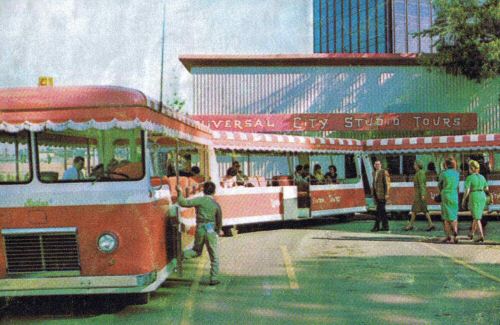
Boarding GlamorTrams at Lankershim Blvd., 1964
Despite these early hiccups, the first tour opened on June 17th 1964* with tickets being sold out of a temporary trailer on Lankershim Blvd. The Universal Studio Tour at that time consisted of two trams and a handful of eager young tour guides; including John Ford III (grandson of famous western director John Ford) and Dan Milland (son of Academy Award winning actor Ray Milland). The early tour was 90 minutes and included a stop off at the studio commissary for lunch and a make-up show (presented by Mike Westmore of the famous Westmore family of make-up artists) held in the commissary basement. 38,184 guests rode the Universal Studio Tour in its first year.
[* the date of the first tour is a little unclear – see the History page for details]
The first expansion to the tour was the addition of Prop Plaza, an intermediate rest stop that included the tour’s first “animation”; a model T Ford on a mechanical gimbal with a rotating canvas cyclorama. Prop Plaza was also the site of the first version of the Western Stunt Show. The Tour quickly grew in popularity and the early designers tried to cope with the increasing demand. Al Dorskind made a deal with Cal Trans to remove the top of a large hill on the Universal property for a new Tour Center (Cal Trans used the dirt in the construction of the Hollywood Freeway). The Tour Center eventually became the top deck of the Universal Studios Theme Park. Barry Upson, leading the earliest version of Universal Creative in conjunction with the Studio Art Department and Mill, set to work on creating new attractions for the tour including the Parting of the Red Sea, The Flash Flood and the Collapsing Bridge. All of these famous attractions have stood the test of time and are still featured on the Studio Tour. As the Universal Studios Theme Park expanded, so did the Studio Tour as later expansion brought the attractions Jaws, King Kong, Earthquake and The Curse of The Mummy’s Tomb.
Many of the early tour attractions, however, did not stand the test of time and have been replaced over the years to make way for new expansion. Theme park aficionados will fondly recall such quirky attractions as the Submarine Attack, The Avalanche, The Runaway Train, The Burning House, The Ice Tunnel, Battle of Galactica and perhaps the strangest attraction of all…a mechanical gorilla holding a severed human arm that used to “swing” through Tarzan’s Jungle.
Of course, the biggest and most unpredictable “attraction” of the Studio Tour has always been the prospect of seeing a movie star. Since it’s inception, the Studio Tour has strived to get guests as close to filmmaking as possible. This necessitates daily, sometimes hourly, changes to the tour route. Over the years, the tram has had some rather unique encounters with Hollywood stars including a head-on collision with John Travolta’s Rolls Royce (Mr. Travolta signed autographs and posed for pictures with the surprised guests) and being terrorized by a rubber knife wielding Mother Bates at the Psycho house (actually Jim Carrey in disguise)!
The one constant element of the Studio Tour that has remained unchanged down through the years is the Universal Studio Tour Guide. From the original staff of half a dozen guides to the current staff that numbers well over 150; these “Ambassadors to Hollywood” have always been a key ingredient to the success and longevity of the Studio Tour. Every year 2,000 eager hopefuls apply for the 50 or so available tour guide positions. The intensive three-week training program is like the Entrainment Industry’s equivalent of boot camp with the guides being tested on their verbal skills, media usage and a written examination with questions randomly pulled from the 260-page Guide Manual. By the end of the three weeks, the guides are transformed into experts on Universal Studios and the Entertainment Industry.
From day one, the Studio Guide position has always been intended to be as a stepping-stone to a career in Hollywood. Today former Studio Guides occupy positions at every level and occupation in the entertainment industry including actors, writers, directors, producers, casting agents, publicists and yes, even theme park designers. Some of Universal Studios famous tour guide alumni include, director John Badham (Saturday Night Fever), studio executive Michael Ovitz, actor Michael Hitchcock (Best in Show) and singer Jack Wagner (All I Need).
Today the Studio Tour continues to evolve. In the Summer of 2000 Universal brought the tram into the 21st Century with the debut of The New Studio Tour. This exciting update of Universal’s time-honored attraction transformed the tram into a “Movie Theater on Wheels” with the inclusion of LCD video monitors, a state-of-the-art audio system, on-board video cameras and DVD players containing over 200 pieces of custom produced media. For the first time ever, guests are able to see examples of how the Universal lot has been used for motion picture and television production and learn about filmmaking from the world’s greatest filmmakers.
Often imitated but never duplicated, The Universal Studio Tour is still the place to go to get into the movies!
